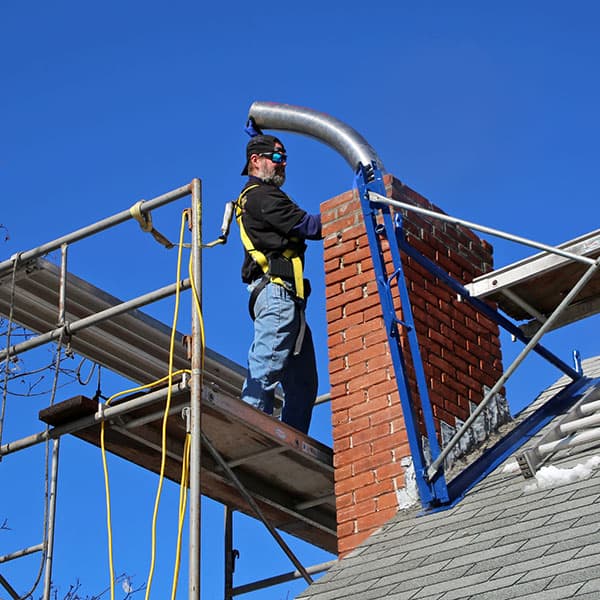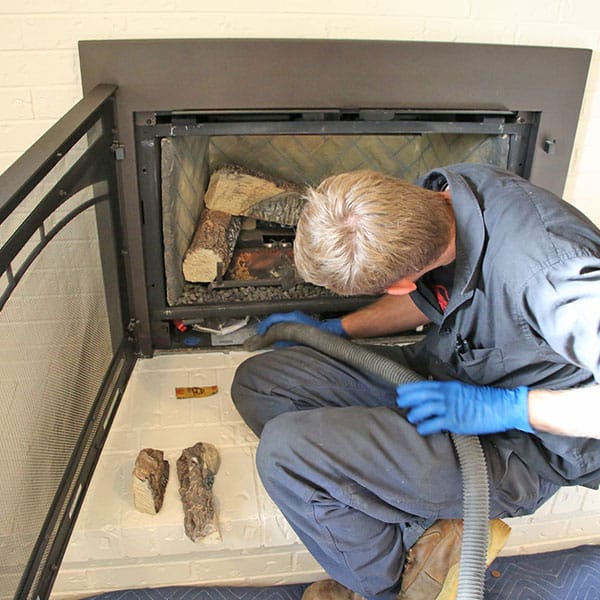Your chimney liner protects your home from dangerous gases and heat damage. Learn the key warning signs that indicate it's time for replacement.
Share:

Chimney liner problems rarely announce themselves with obvious signs. Most damage happens inside your flue where you can’t see it, gradually compromising your home’s safety.
The key is knowing what to look for during your regular fireplace use. Strange smells, poor draft, or visible damage around your fireplace opening often signal liner issues that need immediate attention.
We use specialized cameras to inspect areas you can’t reach, but there are warning signs you can spot yourself between annual inspections.

When smoke starts entering your living space instead of going up the chimney, your liner system isn’t working properly. This isn’t just annoying—it’s dangerous.
A damaged liner can’t create the proper draft needed to pull smoke and gases up and out of your home. Cracks or gaps in the liner disrupt airflow, causing smoke to back up into your room instead of venting safely outside.
You might notice this problem most when you first light a fire, when wind conditions change, or during certain weather patterns. Don’t ignore it or try to “work around” the issue by opening windows or adjusting your damper.
Poor draft can also indicate blockages, structural damage, or improperly sized liner systems. In Massachusetts, where freeze-thaw cycles can crack liner materials over time, this problem often develops gradually before becoming noticeable.
If you’re experiencing smoke backup, stop using your fireplace immediately. Carbon monoxide and other toxic gases that should be venting outside are instead entering your living space. Professional inspection can determine whether liner repair or full replacement is needed to restore safe operation.
The longer you wait to address draft problems, the more exposure your family faces to harmful gases. We have the tools and expertise to diagnose the root cause and recommend appropriate solutions.
White chalky residue or rust stains appearing on your fireplace walls, chimney exterior, or surrounding masonry signal serious liner problems that demand immediate attention.
The white staining, called efflorescence, occurs when moisture penetrates your chimney system through cracks or gaps in a damaged liner. As water moves through the masonry, it carries mineral salts to the surface, leaving behind those telltale white deposits.
Rust streaks indicate that metal components in your chimney system are corroding, often due to moisture infiltration through a compromised liner. This moisture doesn’t just cause cosmetic damage—it can weaken your entire chimney structure over time.
In Norfolk and Plymouth counties, coastal moisture accelerates these problems. The salt air can speed up corrosion of metal components like dampers, flashing, and chimney caps, while freeze-thaw cycles cause additional stress on compromised liner systems.
These stains aren’t just aesthetic issues. They’re warning signs that water is getting where it shouldn’t be, potentially causing carbon monoxide leaks, structural damage, or creating conditions for dangerous gas buildup in your home.
Moisture infiltration through damaged liners can also lead to mold growth, deteriorating masonry, and expensive structural repairs if not addressed quickly. The longer moisture has access to your chimney interior, the more extensive and costly the necessary repairs become.
Professional inspection can determine the extent of liner damage and whether repair or full replacement is needed. Don’t wait for these warning signs to worsen—early intervention prevents minor problems from becoming major safety hazards and expensive emergency repairs.
Unusual smells coming from your fireplace or chimney area often indicate liner problems that pose immediate safety risks. These odors can signal everything from structural damage to dangerous gas leaks.
Strong, persistent odors that appear even when you’re not using your fireplace suggest that your liner isn’t properly containing combustion byproducts. This means potentially toxic gases could be entering your living space.
The type of smell can help identify the specific problem, but any unusual chimney odor warrants professional inspection to ensure your family’s safety.

Musty, damp, or moldy odors coming from your fireplace area indicate water is entering your chimney system through cracks or gaps in your liner. This moisture infiltration creates the perfect environment for mold and mildew growth.
Water infiltration through damaged liners doesn’t just cause unpleasant smells. It can lead to serious structural damage as moisture penetrates your chimney’s masonry, weakening mortar joints and causing bricks to deteriorate from the inside out.
In Massachusetts, where freeze-thaw cycles are common, water that enters through liner cracks can freeze and expand, causing additional damage to your chimney structure. This creates a cycle where small cracks become larger problems over time.
The musty smell often becomes more noticeable during humid weather or after rain, when moisture levels in your damaged chimney system increase. You might also notice this odor more strongly during certain seasons when temperature changes affect how air moves through your chimney.
Mold growth from moisture infiltration can affect your home’s air quality, potentially causing health issues for family members, especially those with allergies or respiratory conditions. The longer moisture has access to your chimney interior, the more extensive the mold problem can become.
We can identify the source of moisture infiltration and determine whether liner repair or replacement is needed. We can also assess any structural damage caused by water infiltration and recommend appropriate repairs to prevent future problems.
Don’t ignore musty odors from your fireplace area. Early detection and repair of liner problems prevent minor moisture issues from becoming major structural damage and health hazards.
Chemical odors, acrid smells, or burning scents coming from your fireplace when it’s not in use indicate serious liner problems that require immediate professional attention. These smells often signal that combustion byproducts aren’t being properly contained and vented.
A damaged liner can allow creosote, tar, and other combustion residues to penetrate your chimney walls, where they continue to emit strong odors even between fires. These substances can also create fire hazards if they accumulate in areas where they shouldn’t be.
Strong chemical smells might also indicate that gases from other appliances—like your furnace, water heater, or neighboring chimneys—are entering your home through compromised liner systems. This cross-contamination poses serious health and safety risks.
In some cases, these odors become more noticeable during temperature changes, when air pressure differences cause gases to move differently through your chimney system. You might smell these odors more strongly on windy days, during weather changes, or when your heating system cycles on and off.
Burning smells when your fireplace isn’t in use can indicate that heat from other sources is affecting combustible materials that have accumulated in areas where your damaged liner has allowed them to penetrate. This creates potential fire hazards that require immediate attention.
These chemical odors can also affect your home’s air quality and potentially cause headaches, respiratory irritation, or other health issues for your family. Children and elderly family members may be particularly sensitive to these toxic fumes.
Professional inspection can determine the source of these odors and assess the extent of liner damage. Depending on the severity of the problem, solutions might range from liner repair to complete replacement, along with cleaning of affected areas to remove accumulated combustion residues.
Never ignore strong chemical or burning smells from your fireplace area. These odors often indicate conditions that pose immediate fire and health hazards, requiring prompt professional intervention to restore safe operation.
Recognizing these warning signs early can save you thousands in emergency repairs and, more importantly, protect your family from dangerous gas exposure and fire hazards. Your chimney liner plays a critical role in your home’s safety—when it fails, the consequences can be severe.
Professional inspection using specialized cameras can reveal problems you can’t see from inside your home. Modern Massachusetts building codes require proper liner systems for good reason, and ignoring these warning signs puts your family at unnecessary risk.
If you’ve noticed any of these signs in your Norfolk, Plymouth, or Bristol County home, don’t wait for the problem to worsen. We provide expert liner inspection, repair, and replacement services designed to restore your chimney’s safe operation and give you peace of mind.
Article details:
Share: